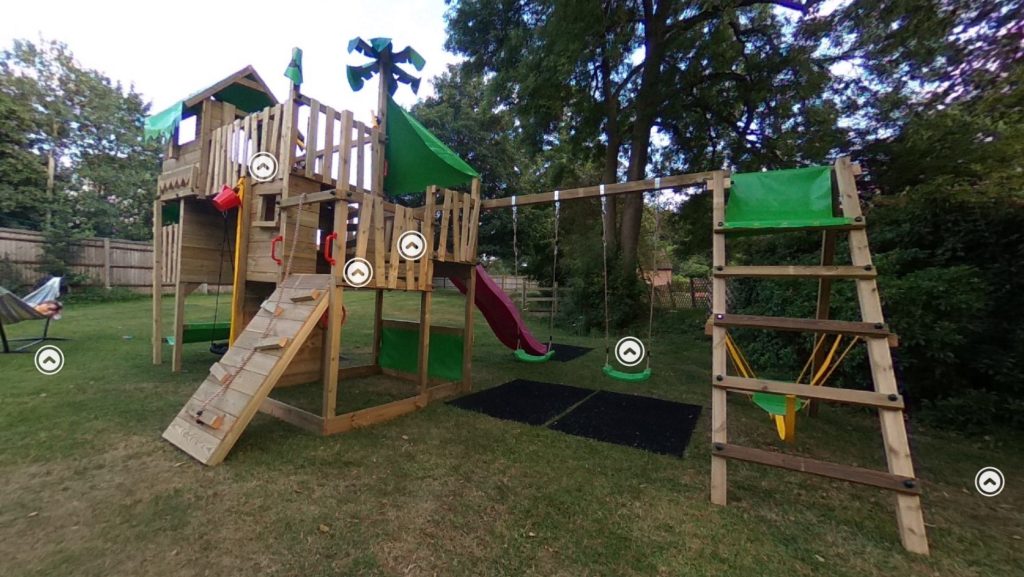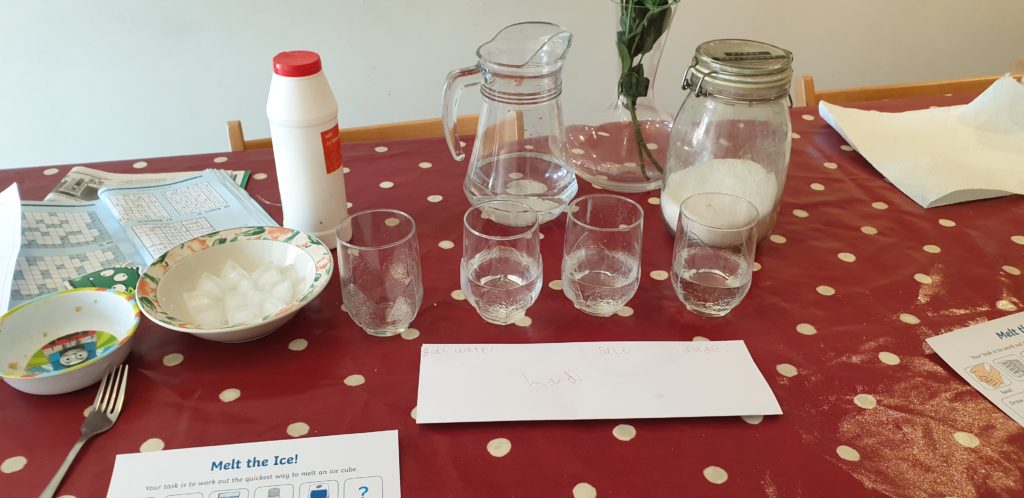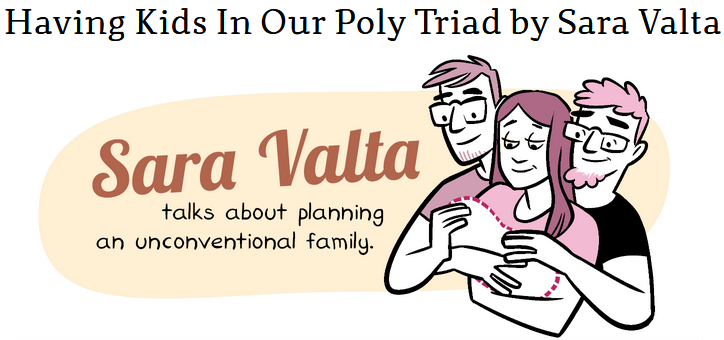Jack and the Beanstalk, as told by the kids via paper puppets. With thanks to Robin for direction, camera operation, editing and – I’m guessing – creative consultancy.
Tag: children
Having Kids In Our Poly Triad by Sara Valta
This is a repost promoting content originally published elsewhere. See more things Dan's reposted.
Sara’s back! You might remember a couple of years ago she’d shared with us a comic on her first year in a polyamory! We’re happy to have her back with a slice of life and a frank n’ real conversation about having kids in her Poly Triad relationship.
This sort of wholesome loving chat is just the thing we need for the start of 2021.
…
Start your year with a delightful comic about the author negotiating possible future children in a queer polyamorous triad, published via Oh Joy Sex Toy. Sara previously published a great polyamory-themed comic via OJST too, which is also worth a look.
Why children stay silent following sexual violence
This is a repost promoting content originally published elsewhere. See more things Dan's reposted.
I’ve been thinking a lot lately about the messages we send to our children about their role, and ours as adults, in keeping them safe from people who might victimise them. As a society, our message has changed over the decades: others of my culture and generation will, like me, have seen the gradual evolution from “stranger danger” to “my body, my choice”. And it’s still evolving.
But as Kristin eloquently (and emotionally: I cried my eyes out!) explains, messages like these can subconsciously teach children that they alone are responsible for keeping themselves from harm. And so when some of them inevitably fail, the shame of their victimisation – often already taboo – can be magnified by the guilt of their inability to prevent it. And as anybody who’s been a parent or, indeed, a child knows that children aren’t inclined to talk about the things they feel guilty about.
And in the arms race of child exploitation, abusers will take advantage of that.
What I was hoping was to have a nice, concrete answer – or at least an opinion – to the question: how should we talk to children about their safety in a way that both tries to keep them safe but ensures that they understand that they’re not to blame if they are victimised? This video doesn’t provide anything like that. Possibly there aren’t easy answers. As humans, as parents, and as a society, we’re still learning.
Further watching, if you’ve the stomach for it: this Sexplanations episode with Dr. Lindsey Doe and Detective Katie Petersen.
I got married and had kids so you don’t have to
This is a repost promoting content originally published elsewhere. See more things Dan's reposted.
…
I’m sure that the graveyard of over-optimism is littered with the corpses of parents who planned to help their children learn self-moderation by showing them the wonders of nature, but who realized too late that fields of wheat don’t stand a chance against Rocket League. I’m hoping that we can agree that computer games are good, but other things are good too, cf fields of wheat. I don’t want to have to sneak in my own gaming time after my son has gone to bed. I also don’t want to be a hypocrite; at least, I don’t want Oscar to know that I’m a hypocrite. Maybe we can play together and use it as father-son bonding time. This might work until he’s ten and after he’s twenty-five.
…
Robert Heaton, of Programming Projects for Advanced Beginners fame and reverse-engineering device drivers that spy on you (which I’ve talked about before), has also been blogging lately about his experience of Dadding, with the same dry/sarcastic tone you might be used to. This long post is a great example of the meandering thoughts of a (techie) parent in these (interesting) times, and it’s good enough for that alone. But it’s the raw, genuine “honesty and dark thoughts” section towards the end of the article that really makes it stand out.
Think Like a Tomato
This is a repost promoting content originally published elsewhere. See more things Dan's reposted.
Smallest child, while watering plants: “To grow a tomato, we have to think like a tomato!”
Adorable.
Also: I want him on my side when the killer tomatoes attack.
Building a Playframe (Timelapse Video)
This week, with help from Robin and JTA, I built a TropicTemple Tall XXL climbing frame in the garden of our new house. Manufacturer Fatmoose provided us with a pallet-load of lumber and a sack of accessories, delivered to our driveway, based on a design Ruth and I customised using their website, and we assembled it on-site over the course of around three days. The video above is a timelapse taken from our kitchen window using a tablet I set up for that purpose, interspersed with close-up snippets of us assembling it and of the children testing it out.

I’ve also built a Virtual Tour so you can explore the playframe using your computer, phone, or VR headset. Take a look!
The video is also available via:
Dan Q found GC4XEPP School Run
This checkin to GC4XEPP School Run reflects a geocaching.com log entry. See more of Dan's cache logs.
A second quick geocache find while the 6 year-old and I took a stroll around the village, which – as of yesterday – became our home! Nice to see the lights here that’ll help protect her during our “school runs”!
Tour of our old house
We’ve only got a couple of days left before we move to our new house. In order that she and her little brother might better remember our old house, I encouraged our 6 year-old to record a video tour.
Also available via:
Pyjama Party Water Fight
There comes a point where you’ve run out of new lockdown activity ideas, and you just start combining random pairs of activities you’ve already done. This morning’s first activity was… “Pyjama Party / Water Fight”.
Is it just me, or does “Pyjama Party / Water Fight” sound like a PWL song title?
Fox In Sox
This is a repost promoting content originally published elsewhere. See more things Dan's reposted.
This is the best rap music-related thing to happen to Dr. Seuss since Wubble Down, over 10 years ago. And understand that there have been a lot of strong candidates.
(I maintain that I’m not that “into” rap music. But somehow I keep proving myself wrong. Loving this song right now, for example.)
Gratitude
In these challenging times, and especially because my work and social circles have me communicate regularly with people in many different countries and with many different backgrounds, I’m especially grateful for the following:
- My partner, her husband, and I each have jobs that we can do remotely and so we’re not out-of-work during the crisis.
- Our employers are understanding of our need to reduce and adjust our hours to fit around our new lifestyle now that schools and nurseries are (broadly) closed.
- Our kids are healthy and not at significant risk of serious illness.
- We’ve got the means, time, and experience to provide an adequate homeschooling environment for them in the immediate term.
- (Even though we’d hoped to have moved house by now and haven’t, perhaps at least in part because of COVID-19,) we have a place to live that mostly meets our needs.
- We have easy access to a number of supermarkets with different demographics, and even where we’ve been impacted by them we’ve always been able to work-around the where panic-buying-induced shortages have reasonably quickly.
- We’re well-off enough that we were able to buy or order everything we’d need to prepare for lockdown without financial risk.
- Having three adults gives us more hands on deck than most people get for childcare, self-care, etc. (we’re “parenting on easy mode”).
- We live in a country in which the government (eventually) imposed the requisite amount of lockdown necessary to limit the spread of the virus.
- We’ve “only” got the catastrophes of COVID-19 and Brexit to deal with, which is a bearable amount of crisis, unlike my colleague in Zagreb for example.

Whenever you find the current crisis getting you down, stop and think about the things that aren’t-so-bad or are even good. Stopping and expressing your gratitude for them in whatever form works for you is good for your happiness and mental health.
Homeschooling While Working From Home During a Global Pandemic Bingo
This is a repost promoting content originally published elsewhere. See more things Dan's reposted.
The Happy Song
This is a repost promoting content originally published elsewhere. See more things Dan's reposted.
I’m sure that this music video is supposed to be for children, but between its plasticine-and-fuzzy-felt simplicity and the delightful, joyous, carefree song I can’t help but dance along.
‘There’s zero evidence that it’s worse for children’
This is a repost promoting content originally published elsewhere. See more things Dan's reposted.
…
“Even at a young age, I was able to grasp the concept that my mum and dad could love more than one person,” he says. “The only thing I’ve found challenging about having three adults in my family is getting away with things, because it means more people to check up on you, to make sure you did your chores. But I also have more people around to give me lifts here and there, to help with homework and to come to my lacrosse games. The saying ‘raised by a village’ definitely applies to me. I feel like a completely normal teenager, just with polyamorous parents.”
…
Yet another article providing evidence to support the fact that – except for the bigotry of other people – there are no downsides to being a child of polyamorous parents. Nicely-written; I’ve sent a copy of Alan for the Poly In The Media blog.
Parent-child play: It’s constant and exhausting, but is there a better way?
This is a repost promoting content originally published elsewhere. See more things Dan's reposted.
…
It’s worth noting here that the idea that a parent should be a caretaker, educator, and entertainer rolled into one is not only historically, but also culturally specific. “There are lots of cultures where [parent-child play is] considered absolutely inappropriate—a parent would never get down on their knees and play with the children. Playing is something children do, not something adults do,” developmental psychologist Angeline Lillard said in an interview. “And that’s just fine. There’s no requirement for playing.”
Differences in practices around parent-child play exist within American subgroups, too. Sociologist Annette Lareau has observed a gap in beliefs about parent-child play between working-class/poor parents and middle-class parents in the United States. Working-class and poor parents in her study held a view that they were responsible for “supervision in custodial matters” (Did the child get to sleep on time? Does the child have sneakers that fit?) and “autonomy in leisure matters,” while the middle-class parents engaging in what Lareau termed “concerted cultivation” invested themselves heavily in children’s play. Ultimately, the poorer kids, Lareau found, “tended to show more creativity, spontaneity, enjoyment, and initiative in their leisure pastimes than we saw among middle-class children at play in organized activities.”
…
Interesting article (about 10 minutes reading), so long as you come at it from at least a little bit of an academic, anthropological perspective and so aren’t expecting to come out of it with concrete, actionable parenting advice!
Engaging in some kinds of play with your kids can be difficult. I’ve lost count of the hours spent in imaginative play with our 6-year-old, trying to follow-along with the complex narrative and characters she’s assembled and ad-lib along (and how many times she’s told me off for my character not making the choices she’d hoped they would, because she’s at least a little controlling over the stories she tells!). But I feel like it’s also a great way to engage with them, so it’s worth putting your devices out of sight, getting down on the carpet, and playing along… at least some of the time. The challenge is finding the balance between being their perpetual playmate and ensuring that they’re encouraged to “make their own fun”, which can be an important skill in being able to fight off boredom for the rest of their lives.
If I ever come up with a perfect formula, I’ll tell you; don’t hold your breath! In the meantime, reading this article might help reassure you that despite there almost-certainly not being a “right way”, there are plenty of “pretty good ways”, and the generally-good human values of authenticity and imagination and cooperation are great starting points for playing with your children, just like they are for so many other endeavours. Your kids are probably going to be okay.

